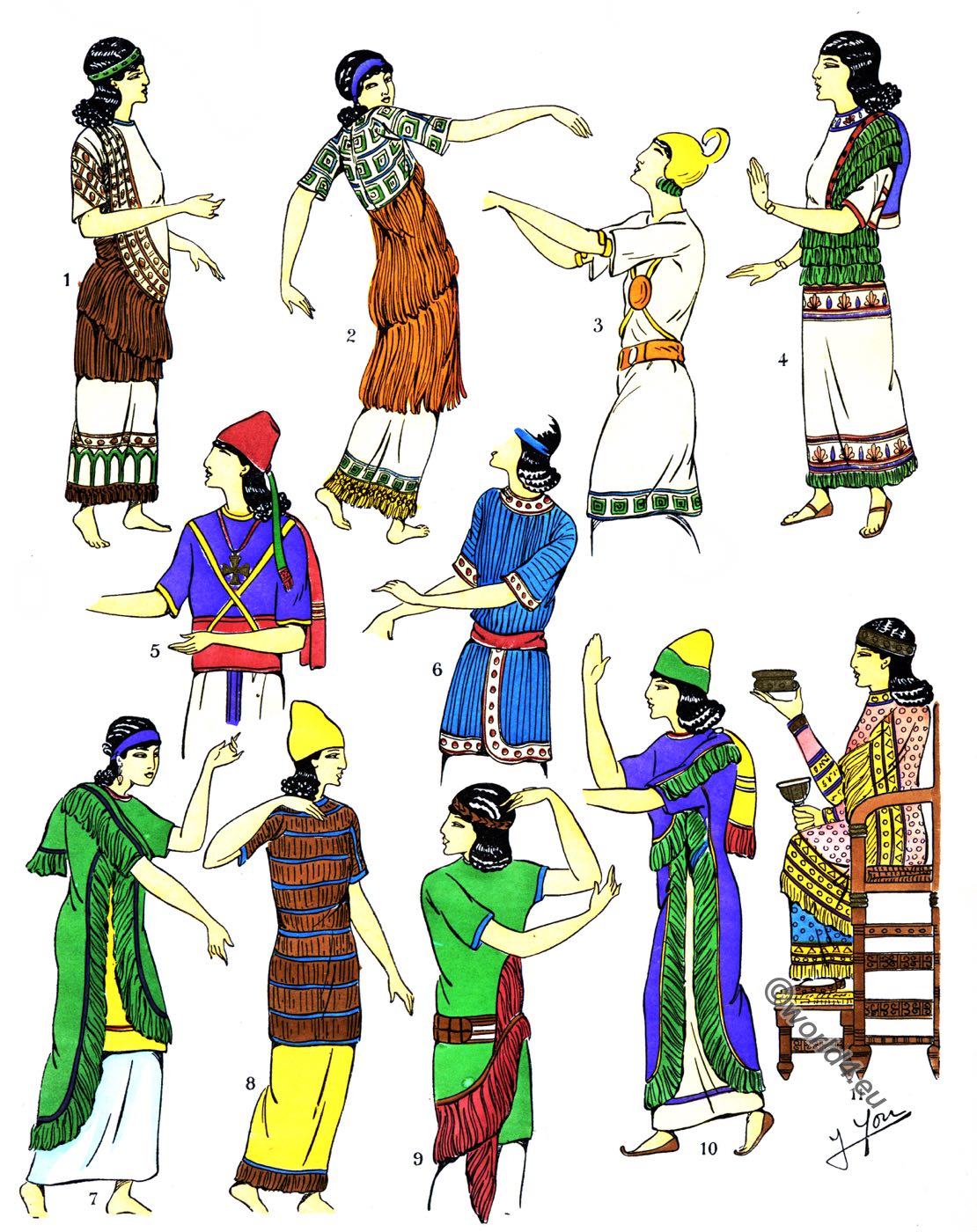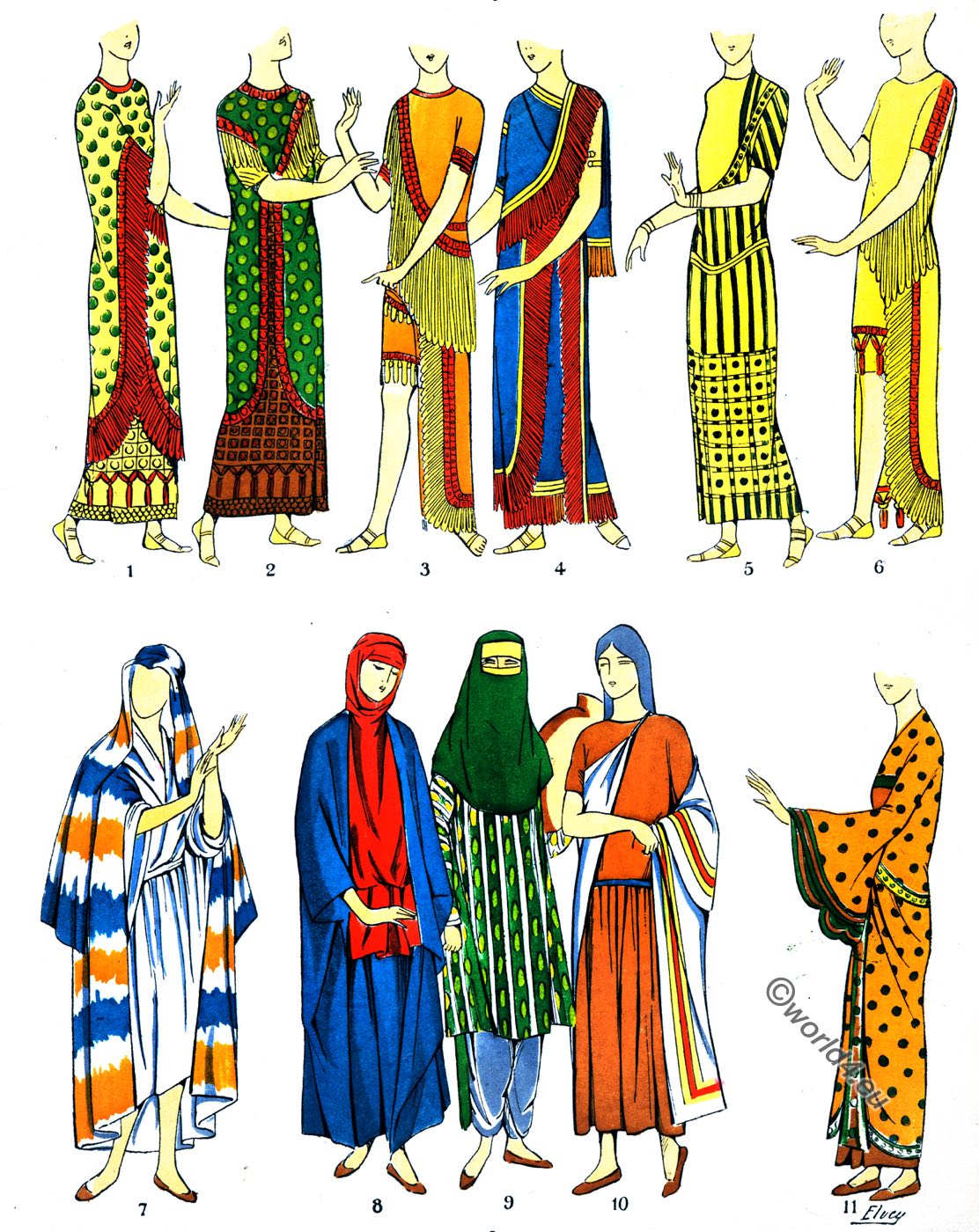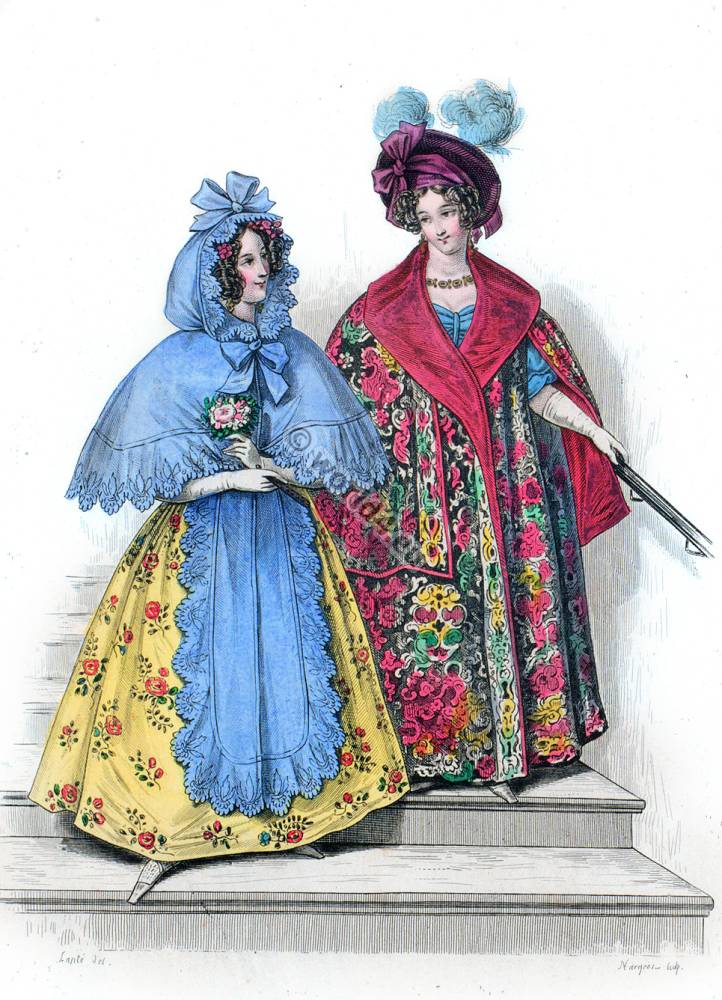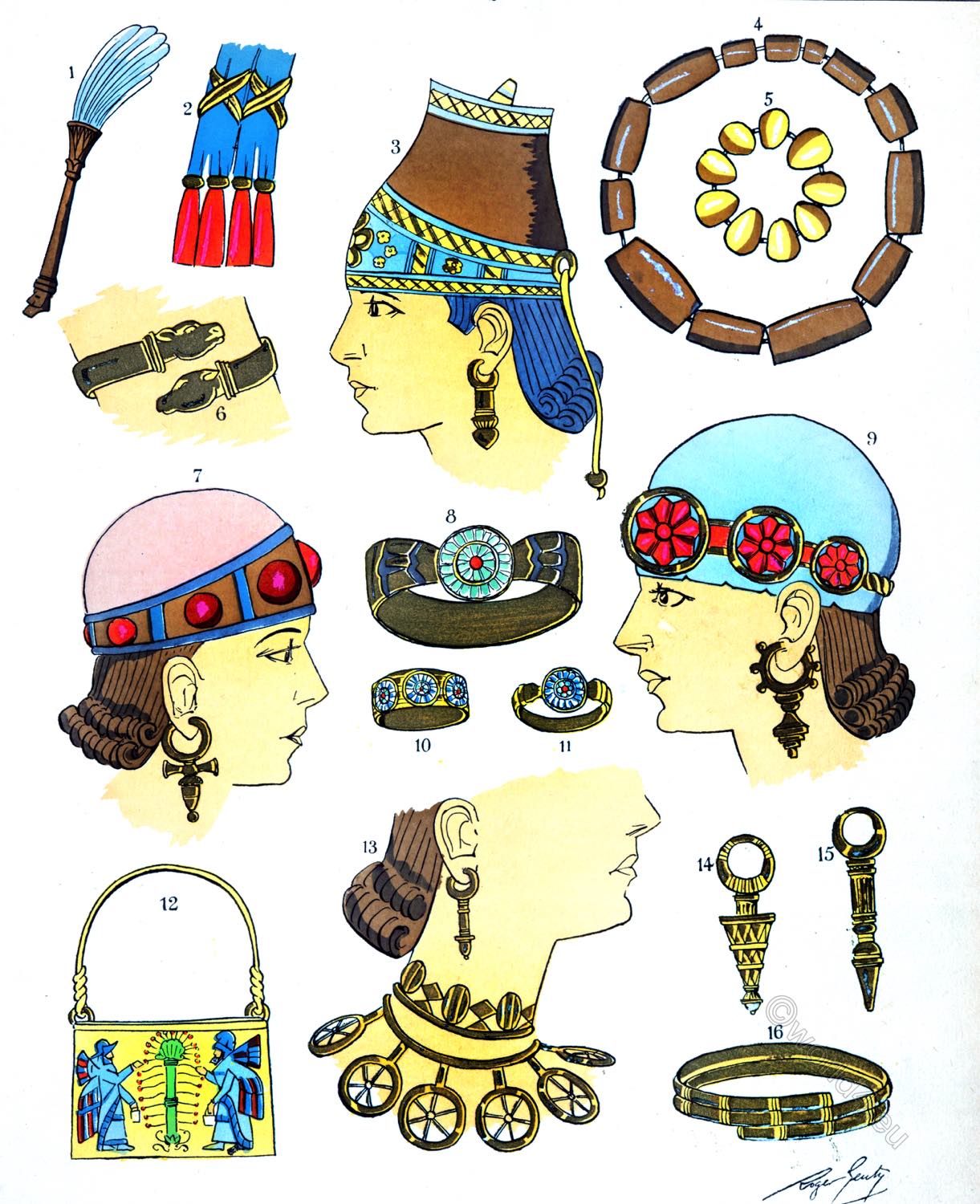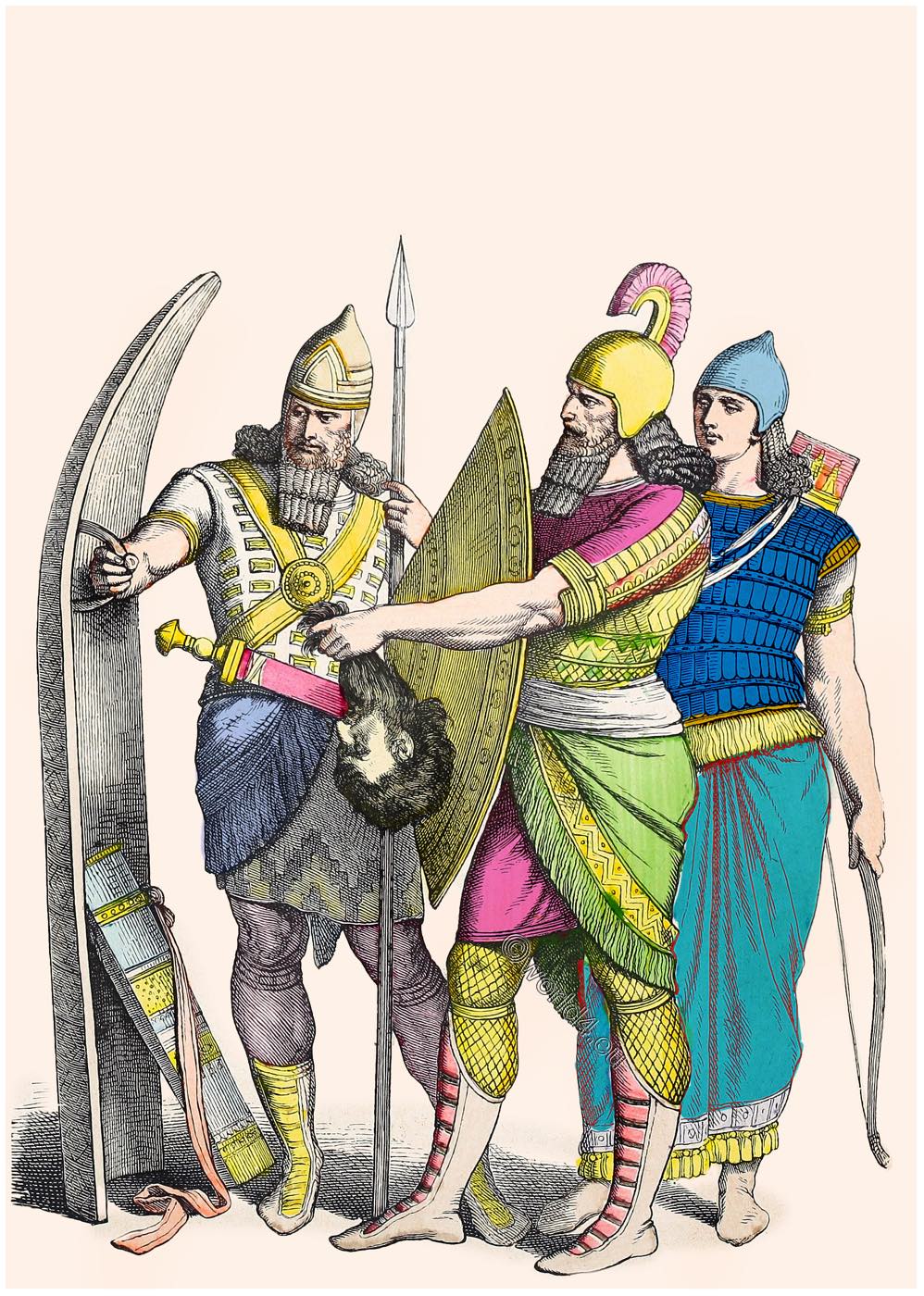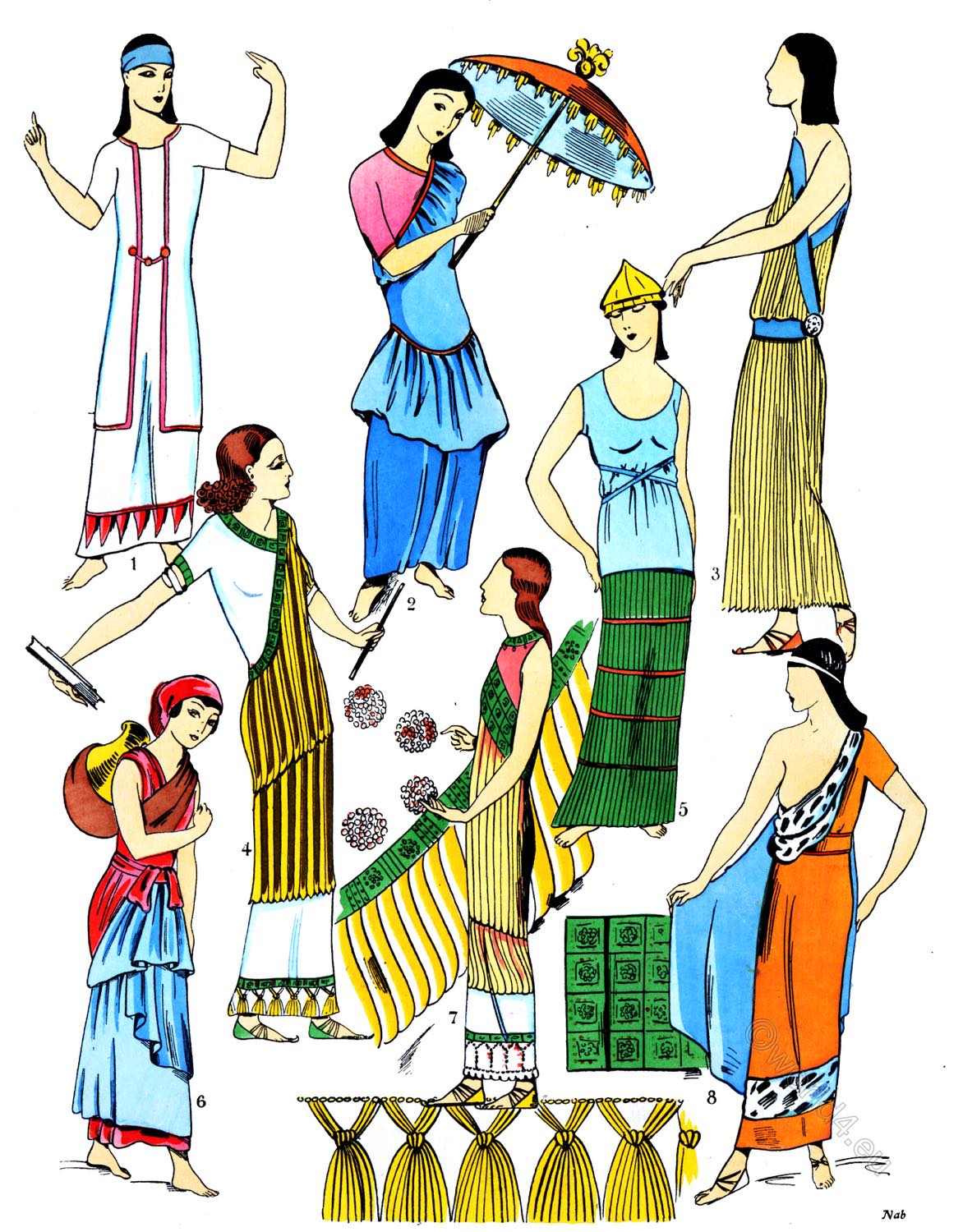
Part V. The Luxurious Assyrian Costumes.
Skirts.
Assyrian Plate 5.
- Straight-cut gown with long coat and short sleeves.
- Gown with a sort of draped pannier and double facing, embroidered with a galloon similar to the belt.
- Gown entirely pleated, fastened at the side by a jewellery ball.
- Long straight tunic, partly covered with a garment of gold embroidery.
- Double-belted cassock over a pleated skirt with plain bands laid across.
- Common woman’s dress, draped in front and completed with a cap.
- Gala dress with bolero of embroidered cameos and beaded hem.
- Gown drawn in at the waist by a broad belt, with a facing and a band of ermine.
Embroidery. Skirts.
Assyrian dresses were richly ornamented, the opening of the dress and the bottom of the skirt bearing a double row of rosettes and long fringes; further the front-opening was ornamented all around with a double cord, the ends of which were knotted and floated about loose. The visible part of the inner tunic or slip had but one row of rosettes from which hung a series of tassels.
Fringes occupy an important place in Assyrian dress, and gave them the appearance of having wrapped themselves up it fringed curtains, the more so as the fringes were placed obliquely.
MATERIALS. – Even in our time in the Bazaars of Persia and Turkey, it is possible to find certain table cloths in which pieces of different materials make an agreeable mosaic pattern. There are certain details in this work, as in the old materials, which were certainly common to other forms, and which were in all probability embroideries executed in what we call the feather stitch; this however is of minor importance, greater interest attaching to the design and the taste which conceived and executed it.
DECORATION. – The principle of this decoration is more or less that which we find in the carved bronzes. Round a central figure are parallel bands over which groups of figures are symmetrically arranged. Narrow bands edge the whole, and bear chiefly decorations taken from the vegetable kingdom, conventional flowers, rosettes and palm-leaves.
RELIGIOUS IMAGES. – Nearly all these figures have a markedly religious character, being also carved and enamelled on the gates of the Palace. Here are beings in adoration before the holy tree, or flying through space, or playing with lions; there the king seems to be the central figure, worshipping the winged globe and the holy plant, or standing between two winged genii who seem to be speaking to him, perhaps instructing him.
All these pictures are cleverly spread into compartments separated by pleasingly curved lines, and although empty spaces are avoided, they are so well arranged as to be perfectly clear.
MESOPOTAMIA. – Nowhere more, perhaps, than in Mesopotamia, had artists shown such ability or shown evidence of such inventive faculty. Here at least there is no sign of that heaviness that is to be seen in some of their jewellery. A detailed investigation will but confirm the good impression left by a cursory glance. One is struck by the wealth of variety in the combinations used by the embroiderer. Sometimes a line ornament, sometimes one flowery, sometimes, as on this square of Nimrod, a winged figure.
A further design is the holy tree, the palm leaf above, and on either side bands ornamented with a rosette and herring-bone pattern, another a winged lion, with a human face, bearded and mitred, who fights against an eagle-headed genius.
A flower, whose shape makes us think of the silence plate, hangs from the middle of the band and forms an ornament to complete a necklace. Mythological animals are mixed with real; two griffons fell a dappled deer, or else appear alone with something so unexpected and singular in their attitude that one is forced to smile, this is also the case with the winged bulls which perch on large disks in the form of wide-open flowers. Finally the king himself, or somebody resembling him, is shown fighting with monsters.
WEAVERS. – Weavers in their way were no less ingenious than embroiderers, but could not give free rein to their imagination, for the shuttle is less supple than the needle, and running through the threads can only make symmetrical designs to be repeated though all the width of the material the principal design always remaining the same.
CARPETS. – The composition varied as much in those days as it does now in the carpets that are supplied by Turkey and Persia. There was in any case always a border, for which the softest and most delicate colours were used, usually ornamented by one of those garlands of flowers which were perhaps borrowed from Egypt.
Sometimes the space thus surrounded was divided into little squares, sometimes filled with a single design, such as a six-petalled flower occupying almost the whole of a piece of material. These patterns were used for door-mats and rugs.
SLEEVES. – Assyrian sleeves are very simple, generally short, of plain cloth, with very little ornamentation, narrow and tight round the arm.
They all seem to be cut from the same block pattern. Doubtless the shawl which covered the shoulders of the women imitated sleeves, rendering the latter unnecessary, at least in winter, for in the summer, as in all hot countries, Egypt and elsewhere, sleeves, were absolutely useless. Have we not seen, also, that tirewomen and men-servants went about their work naked to the waist?
The sleeve-shawl, which is to be seen in the bas-reliefs, was of nomadic origin, and is mentioned thus by Monsieur Dieulafoy in his interesting volume upon the ruins of the Acropolis of Suze, *) in Suziana. The patriarchal cloak served innumerable purposes, such as headgear, shoulder-cover, sleeves, bed, and blanket, all at the same time.
The great families, whose great possessions were known as Beni felt the necessity of grouping themselves round the wisest or the bravest for mutual protection against the attacks of their enemies, and that they might be enabled to plunder the goods of their neighbours with less risk to themselves. Hence the family become a tribe and a collection of tribe formed a colony.
*) Susa was an ancient city in southwestern modern Iran near the Iraqi border in Khuzestan province on the outskirts of the modern city of Shush. Susa is one of the oldest continuously inhabited cities in the world.
Continuing
Discover more from World4 Costume Culture History
Subscribe to get the latest posts sent to your email.

